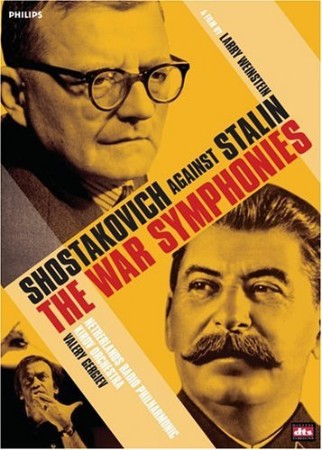
The War Symphonies: Shostakovich against Stalin 1997
Distributed by Bullfrog Films, PO Box 149, Oley, PA 19547; 800-543-FROG (3764)
Produced by Rhombus Media
Directed by Larry Weinstein
VHS, color, 82 min.
High School - Adult
History, Music
Date Entered: 11/09/2018
Reviewed by Brad Eden, Ph.D., Head, Web and Digitization Services, University Libraries, University of Nevada, Las VegasThis video is a montage of film and musical clips, interviews, readings, narration, and photographs of the life of Dimitri Shostakovich during World War II, the period roughly defined by his Fourth through Ninth Symphonies (1936-1945). Interviews with contemporaries still alive in 1997, including many friends and relatives of Shostakovich, talk about his life and ideals which are illustrated through his symphonies, and the response Stalin had to his work. Valery Gergiev and the Netherlands Radio Philharmonic, as well as the Orchestra of Mariinsky Theatre, provide musical portions of Shostakovich's symphonies.
The War Symphonies provides an intense historical perspective on life in Russia during World War II, especially from the perspective of the fine arts. Some rather dramatic film footage of prisoners being shot to death is included during the portion discussing the Fifth Symphony (1937), a point at which Shostakovich's own life was at stake, and his previous symphony had already been banned. The Siege of Leningrad by the Nazis is described and depicted during the discussion of the Seventh Symphony (1941), which premiered in Leningrad during the heart of the siege, and became a rallying point for the Russian masses as well as Stalin's favorite symphony.
I highly recommend this video. Not only does it teach music history, but it also teaches human history, especially the crucial war years from 1936-1945 from Russia's perspective. Shostakovich's music is portrayed by his friends as a struggle between the power of good and evil, and that he tried to juxtapose the individual and the subjective with the collective and the national. He was quoted as saying, "My symphonies are tombstones," as he fully expected to be put to death for the work and the ideals he was trying to portray in his music, namely, his disgust for Stalin's regime and Hitler's destruction. It can be viewed in 20th-century music history classes, 20th-century history classes, as well as graduate classes dealing with World War II.